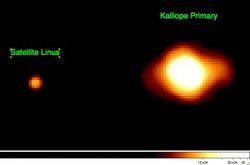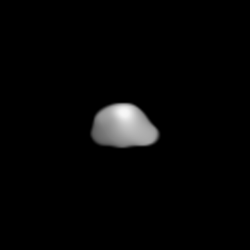Astronomy:22 Kalliope
 Kalliope and satellite Linus as seen by the W.M. Keck II telescope in 2010 | |
| Discovery | |
|---|---|
| Discovered by | John Russell Hind |
| Discovery date | 16 November 1852 |
| Designations | |
| (22) Kalliope | |
| Pronunciation | /kəˈlaɪ.əpi/ kə-LY-ə-pee[1] |
| Named after | Καλλιόπη Kalliopē |
| Minor planet category | Main belt |
| Adjectives | Kalliopean /kəˌlaɪ.əˈpiːən/ kə-LY-ə-PEE-ən |
| Orbital characteristics[2] | |
| Epoch 23 July 2010 (JD 2455400.5) | |
| |{{{apsis}}}|helion}} | 479.98 Gm (3.2085 AU) |
| |{{{apsis}}}|helion}} | 391.03 Gm (2.6139 AU) |
| 435.09 Gm (2.9112 AU) | |
| Eccentricity | 0.10213 |
| Orbital period | 1814.3 d (4.97 yr) |
| Mean anomaly | 282.54° |
| Inclination | 13.703° |
| Longitude of ascending node | 66.17° |
| 355.03° | |
| Known satellites | Linus |
| Physical characteristics | |
| Dimensions | |
| Mean radius | |
| Mass | (7.7±0.4)×1018 kg[4] (8.16±0.26)×1018 kg |
| Mean density | |
| Rotation period | 0.1728 d (4.148 h)[2] |
| Geometric albedo | 0.198[4] 0.17[3] |
| Absolute magnitude (H) | 6.45[2] |
Kalliope (/kəˈlaɪ.əpi/ kə-LY-ə-pee; minor planet designation: 22 Kalliope) is a large M-type asteroid from the asteroid belt discovered by J. R. Hind on 16 November 1852. It is named after Calliope, the Greek Muse of epic poetry. It is orbited by a small moon named Linus.
Characteristics
Kalliope is somewhat elongated, approximately 166 km in diameter,[3] and slightly asymmetric, as evidenced by resolved images taken with the VLT at the European Southern Observatory. This new diameter, which was measured by observing mutual eclipses of Kalliope and Linus, is 8% smaller than that calculated from IRAS observations.[3]
The spectrum of Kalliope is an M-type, indicating that its surface may be partially composed of iron–nickel metal. The asteroid's density is about 3.4 g/cm3.[3] Since the asteroid is likely to be a rubble pile, accounting for a possible porosity of 20–40% leads to the material density of 4.2–5.8 g/cm3, which means that Kalliope is probably made of a mixture of metal with silicates.[3] Spectroscopic studies have shown, however, evidence of hydrated minerals[7] and silicates,[8] which indicate rather a stony surface composition. Kalliope also has a low radar albedo,[5] which is inconsistent with a purely metallic surface.
Lightcurve analysis indicates that Kalliope's pole most likely points towards ecliptic coordinates (β, λ) = (−23°, 20°) with a 10° uncertainty,[9][10] which gives Kalliope an axial tilt of 103°. Kalliope's rotation is then slightly retrograde.
Between 2004 and 2021, 22 Kalliope has been observed to occult fifteen stars.
Satellite
Kalliope has one known natural satellite, called Linus or (22) Kalliope I Linus. It is quite large – about 28 km in diameter – and would be a sizeable asteroid by itself. It orbits about 1100 km from the center of Kalliope, equivalent to about 13.2 Kalliope radii.[3] Linus was discovered on 29 August 2001 by Jean-Luc Margot and Michael E. Brown, while another team led by William Merline also independently detected the moon 3 days later.[5][10]
First stellar occultation
On 7 November 2006, the first stellar occultation by the satellite of an asteroid (Linus) was successfully observed by a group of Japanese observers[11] according to a prediction that was made just one day before by Berthier et al.[12] based on more than 5 years of regular observations of Kalliope binary system using adaptive optics systems on ground-based telescopes. The observed chords of Linus give a unique opportunity to estimate the size of the moonlet which was estimated to 20–28 km.
References
- ↑ calliope (3rd ed.), Oxford University Press, September 2005, http://oed.com/search?searchType=dictionary&q=calliope (Subscription or UK public library membership required.)
- ↑ 2.0 2.1 2.2 2.3 2.4 2.5 "JPL Small-Body Database Browser: 22 Kalliope". http://ssd.jpl.nasa.gov/sbdb.cgi?sstr=22.
- ↑ 3.0 3.1 3.2 3.3 3.4 3.5 3.6 3.7 3.8 3.9 Descamps, P.; Marchis, F. et al. (2008). "New determination of the size and bulk density of the binary asteroid 22 Kalliope from observations of mutual eclipses". Icarus 196 (2): 578–600. doi:10.1016/j.icarus.2008.03.014. Bibcode: 2008Icar..196..578D.
- ↑ 4.0 4.1 4.2 4.3 4.4 Vernazza, P. (October 2021). "VLT/SPHERE imaging survey of the largest main-belt asteroids: Final results and synthesis". Astronomy & Astrophysics 654: A56. doi:10.1051/0004-6361/202141781. Bibcode: 2021A&A...654A..56V.
- ↑ 5.0 5.1 5.2 J.L. Margot; M.E. Brown (2003). "A Low-Density M-type Asteroid in the Main Belt". Science 300 (5627): 1939–1942. doi:10.1126/science.1085844. PMID 12817147. Bibcode: 2003Sci...300.1939M.
- ↑ "EAR-A-5-DDR-TAXONOMY-V6.0". https://sbn.psi.edu/pds/asteroid/EAR_A_5_DDR_TAXONOMY_V6_0/data/taxonomy10.lbl.
- ↑ A.S. Rivkin (2000). "The nature of M-class asteroids from 3-micron observations". Icarus 145 (2): 351–368. doi:10.1006/icar.2000.6354. Bibcode: 2000Icar..145..351R.
- ↑ D.F. Lupishko (1982). "UBV photometry of the M-type asteroids 16 Psyche and 22 Kalliope". Solar System Research 16: 75. Bibcode: 1982AVest..16..101L.
- ↑ M. Kaasalainen (2002). "Models of Twenty Asteroids from Photometric Data". Icarus 159 (2): 369–395. doi:10.1006/icar.2002.6907. Bibcode: 2002Icar..159..369K. http://www.rni.helsinki.fi/~mjk/IcarPIII.pdf.
- ↑ 10.0 10.1 F. Marchis (2003). "A three-dimensional solution for the orbit of the asteroidal satellite of 22 Kalliope". Icarus 165 (1): 112–120. doi:10.1016/S0019-1035(03)00195-7. Bibcode: 2003Icar..165..112M.
- ↑ M. Sôma et al. (2006). "'Occultation by Kalliope (22) and its satellite Linus". Central Bureau Electronic Telegrams 732: 1. Bibcode: 2006CBET..732....1S.
- ↑ J. Berthier et al. (2004). "'Prediction of stellar occultations by satellite of asteroids". AAS/Division for Planetary Sciences Meeting Abstracts #36 32 (23): 1142. Bibcode: 2004DPS....36.3223B.
External links
- Lightcurve plot of 22 Kalliope, Palmer Divide Observatory, B. D. Warner (2007)
- orbit diagram for Linus
- A different VLT image of Kalliope and Linus
- (22) Kalliope, datasheet, johnstonsarchive.net
- Asteroids with Satellites, Robert Johnston, johnstonsarchive.net
- [1], Prediction and Reduction of Stellar Occultations of Binary Asteroids
- 22 Kalliope at AstDyS-2, Asteroids—Dynamic Site
- 22 Kalliope at the JPL Small-Body Database
 |


